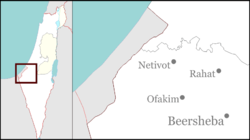- Netzarim (settlement)
-
Netzarim Hebrew נְצָרִים Founded 1984 Coordinates 31°28′55.89″N 34°24′47.96″E / 31.4821917°N 34.4133222°ECoordinates: 31°28′55.89″N 34°24′47.96″E / 31.4821917°N 34.4133222°E Netzarim (Hebrew: נְצָרִים) was formerly an Israeli settlement established in Gaza (about 5 km south-west of the centre of Gaza City) in 1972. It began as a secular Nahal (Young Pioneer) outpost of the Hashomer Hatzair movement; in 1984 it became an orthodox kibbutz. A few years later, the residents decided to change from a kibbutz to a village. It was often referred to in the media as a stronghold for Religious Zionism. Its activities included a mango plantation and vineyard, hothouse cultivated yams and cherry tomatoes, and a prestigious etrog plantation. The settlement also boasted day care centers, kindergartens, a primary school, a kollel, a Yeshiva, and the Jews of Gaza Heritage Institute, which documented Jewish settlement in Gaza over the generations. The development of educational institutions independent from the Gush Katif bloc was due to its isolated location and intensifying Palestinian attacks on traffic using the only route in during the al-Aqsa Intifada. During the last several years of its existence, transportation to and from Netzarim was permitted only with armed military escorts.
Contents
Netzarim Junction
On September 2000, at the outset of the al-Aqsa Intifada, violence increased at Netzarim and at the nearby Israeli military outpost at Netzarim junction located about two kilometres from the village.[1] Netzarim junction being at a crossroads between the only road leaving the village as well as a north-south road used by Palestinians.
On the first day of clashes at the junction, media reported the death of Muhammad al-Dura, turning the junction into a flashpoint.
Eviction
The residents of Netzarim were the last Israelis to be evicted on August 22, 2005 by the Israel Defense Forces during Israel's unilateral disengagement plan from the Gaza Strip ordered by the government of Ariel Sharon. Their eviction marked the end of the Israeli presence in the Gaza Strip since the end of the 1967 Six-Day War. The strong religiosity of its residents was exhibited by seedlings being planted in the greenhouses, cement being laid for a new home that very morning, and a large prayer session in the main synagogue that would later be destroyed by Palestinians after the Israeli army finally abandoned the village on September 12, 2005.
After the eviction, the residents, who had prided themselves in not cooperating with any government agency involved in the eviction, were welcomed in the dormitories of the College of Judea and Samaria by the school administration, students, volunteers and residents of Ariel and the surrounding West Bank settlements. Before the beginning of the academic year, the former residents of Netzarim decided to split up into two groups. One group moved to the temporary government refugee camp of Yevul near the Egyptian border. The other group decided to stay in Ariel.
Operation Cast Lead
IDF took possession of Netzarim again during Operation Cast Lead and entered with 150 Merkava and other military vehicles on January 4, 2009. The reoccupation of Netzarim effectively separated Gaza City from southern Gaza Strip, weakening Hamas' control of the region. On the early morning of January 12, troops stationed at Netzarim began their northward push into Gaza City's Sheikh Ajleen neighborhood. With a ceasefire declared by Israel on January 17, its soldiers gradually evacuated the site of Netzarim.
External links
- Additional pictures
- a clip about the foundation of "Beit Israel" synagogue in Netzer Ariel Community from Rosh Hagiva Site
Notes
- ^ “Three Bullets and a Dead Child” by Esther Schapira (German TV)
Former Israeli settlements in the Gaza Strip Gush Katif Bedolah · Bnei Atzmon · Gadid · Gan Or · Ganei Tal · Katif · Kerem Atzmona · Kfar Darom · Kfar Yam · Morag · Netzer Hazani · Neve Dekalim · Pe'at Sadeh · Rafiah Yam · Shirat HaYam · Slav · Tel KatifaOther Categories:- Former Israeli settlements in the Gaza Strip
- Populated places established in 1972
- Religious Israeli settlements
- Nahal settlements
- Gaza War
- Villages depopulated during the Arab–Israeli conflict
Wikimedia Foundation. 2010.


